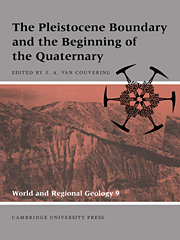Book contents
- Frontmatter
- Contents
- List of contributors
- Preface: the new Pleistocene
- Foreword
- Part I Definition of the base of the Quaternary
- Part II Characterization of the Pleistocene boundary-stratotype
- Part III The paleontological context of the Pleistocene boundary
- Part IV The Pleistocene boundary in regional sequences
- Index
Foreword
Published online by Cambridge University Press: 10 November 2009
- Frontmatter
- Contents
- List of contributors
- Preface: the new Pleistocene
- Foreword
- Part I Definition of the base of the Quaternary
- Part II Characterization of the Pleistocene boundary-stratotype
- Part III The paleontological context of the Pleistocene boundary
- Part IV The Pleistocene boundary in regional sequences
- Index
Summary
Quaternary deposits are everywhere. In mountainous areas they range from thin soils and scree through ephemeral accumulations, such as talus fans and stream alluvium, to sometimes quite long-lived deposits like peat, valley fills, lake beds, and glacial moraines. The acidic ground water and soils of mountains, however, leave few fossils, apart from pollen and macrofloral impressions. In lowland river valleys and coastal margins, continental Quaternary deposits are thicker, more widespread, and more fossiliferous. Even so, they are lithologically and stratigraphically discontinuous on the larger scale. Only in the marine environment, particularly on the floors of the deep ocean basins, are essentially uninterrupted and highly fossiliferous sequences of Quaternary strata found over wide regions. Because the boundary between land and sea has changed very little, relatively, during the geologically brief period of the Quaternary, the early, classic studies of this crucially important interval in the earth's history were restricted to the relatively discontinuous continental deposits. The number of studies of marine Quaternary deposits has increased greatly during the past few decades, however, and they have provided us with a new and much better documented basis from which to establish the position of the lower boundary of the Quaternary.
As far back as 1760, the Italian geologist Arduino singled out Quaternary strata as a distinct group of geological deposits characterized by lack of induration. The concept of a Quaternary time, as the most recent part of geological history, was suggested in 1825 by Desnoyers, and in 1839 Charles Lyell introduced a new term, “Pleistocene,” for the epoch of youngest marine faunas.
- Type
- Chapter
- Information
- The Pleistocene Boundary and the Beginning of the Quaternary , pp. xix - xxiiPublisher: Cambridge University PressPrint publication year: 1996



